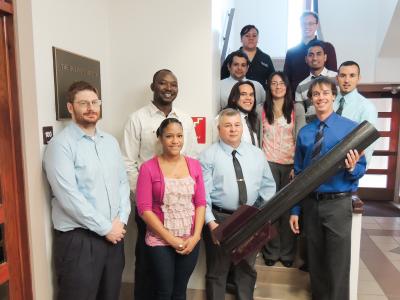NMSU rocketry team selected for NASA competition

The Atomic Aggies, 14 electronics and computer engineering technology seniors, presented their proposal and preliminary designs to NASA this past August. They recently received notification that their rocket will be among the 36 university teams selected through a competitive proposal process for launch.
NASA University Student Launch Initiative, or USLI, is a competition that challenges university students to design, build and launch a reusable rocket with a scientific or engineering payload to one mile above ground level. The project engages students in scientific research and real-world engineering processes with NASA engineers.
Leading their effort is engineering technology Professor Lynn Kelly. The project will serve as the students' senior capstone design course - the culmination of the engineering curriculum at NMSU, requiring students to utilize knowledge and skills acquired throughout their coursework.
"This gives them the opportunity to really develop their skills as engineers," said Kelly, who deems this one of the biggest benefits to students.
Even more beneficial, she said, is the opportunity for students to interact with NASA engineers.
The students make three presentations - preliminary design review, critical design review and flight readiness review - to a panel of scientists and engineers from NASA, NASA contactors and external partners. They also complete a post-launch assessment review to include conclusions from their science or engineering experiment and the overall flight performance.
"The students conduct the presentations via video conference," said Kelly. "After presenting their preliminary design review, the NASA reviewers commented on how professional they were. It's wonderful that people of that caliber were so impressed with our students."
"The process follows NASA's design cycle," she added. "So the students are exposed to a real-world engineering experience."
"I think the most valuable thing from this experience is to be able to work with NASA engineers. The review reports, presentations, leadership and teamwork throughout this process gives valuable work experience that can be used on resumes," said Crystal Escamilla, an engineering technology student who participated as an Atomic Aggie last year.
The team is now in the process of designing their rocket and payload, which will include sensors that will take in-flight measurements at five-second intervals of temperature, humidity, pressure, solar irradiance and ultraviolet radiation. The data will be wirelessly transmitted to a ground station.
The rocket must also be outfitted with GPS transmitter to track its location with a radio receiver on the ground.
"I'm responsible for the recovery of the rocket," said Escamilla. "The recovery bay includes two redundant altimeters that record altitude and also trigger the parachutes at preset altitudes. Our rocket will contain two parachutes, the drogue and the main parachute. The drogue is a smaller parachute that comes out at apogee (the highest point) and the main is set at 500 feet."
A scaled flight test was conducted on Nov. 17 at the Space Model Rocketry Association site in Alamogordo, approved for launching larger rockets.
"It went great," said Kelly.
The students presented their critical design review to NASA on Jan. 14 and a full-scale flight is scheduled for February - an important milestone as a successful full-scale flight is required to continue on to the final launch.
"Every part of the competition is scored including the reports, presentations, educational engagements, the look of the rocket, how the rocket preforms (payload experiment) and how close to a mile it reaches. Therefore, this year we're working at bettering every aspect of the competition. Having last year's experience lets us know where we went wrong and how we can improve it this year," said Escamilla.
Critical to the students' success is mentoring by members of the Fellowship of Las Cruces Area Rocketry Enthusiasts (FLARE).
"We couldn't do this without their guidance and direction," said Kelly.
The group's involvement is equally essential because the rocket can only be launched by someone with a National Association of Rocketry Level 3 High Power Rocket Certification.
Along with design work, preparing reports and presentations, the students are required to conduct community outreach to middle school students. This year's group taught students in Boys and Girls Club how to make rockets out of film canisters.
They also must raise $13,000 for materials and travel expenses to the final launch in Huntsville.
For more information, visit http://atomicaggies.nmsu.edu/.


